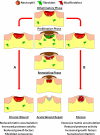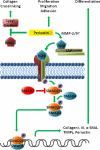Deconstructing fibrosis research: do pro-fibrotic signals point the way for chronic dermal wound regeneration?
- PMID: 21503732
- PMCID: PMC3245760
- DOI: 10.1007/s12079-011-0131-5
Deconstructing fibrosis research: do pro-fibrotic signals point the way for chronic dermal wound regeneration?
Abstract
Chronic wounds are characterized by inadequate matrix synthesis, no re-epithelialization, infection and ultimately no wound resolution. In contrast, fibrosis is characterized by overproduction of matrix and excess matrix contraction. As research in the fields of chronic wounds and fibrosis surges forward, important parallels can now be drawn between the dysfunctions in fibrotic diseases and the needs of chronic wounds. These parallels exist at both the macroscopic level and at the molecular level. Thus in finding the individual factors responsible for the progression of fibrotic diseases, we may identify new therapeutic targets for the resolution of chronic wounds. The aim of this review is to discuss how recent advances in fibrosis research have found a home in the treatment of chronic wounds and to highlight the benefits that can be obtained for chronic wound treatments by employing a translational approach to molecules identified in fibrosis research.
Figures



Similar articles
-
MicroRNA-145-5p regulates fibrotic features of recessive dystrophic epidermolysis bullosa skin fibroblasts.Br J Dermatol. 2019 Nov;181(5):1017-1027. doi: 10.1111/bjd.17840. Epub 2019 Oct 20. Br J Dermatol. 2019. PMID: 30816994
-
Advances in Skin Substitutes-Potential of Tissue Engineered Skin for Facilitating Anti-Fibrotic Healing.J Funct Biomater. 2015 Jul 9;6(3):547-63. doi: 10.3390/jfb6030547. J Funct Biomater. 2015. PMID: 26184327 Free PMC article. Review.
-
Enhancing dermal matrix regeneration and biomechanical properties of 2nd degree-burn wounds by EGF-impregnated collagen sponge dressing.Arch Pharm Res. 2005 Nov;28(11):1311-6. doi: 10.1007/BF02978217. Arch Pharm Res. 2005. PMID: 16350860
-
Integrins in Wound Healing.Adv Wound Care (New Rochelle). 2014 Dec 1;3(12):762-783. doi: 10.1089/wound.2013.0436. Adv Wound Care (New Rochelle). 2014. PMID: 25493210 Free PMC article. Review.
-
Application of decellularized human reticular allograft dermal matrix promotes rapid re-epithelialization in a diabetic murine excisional wound model.Cytotherapy. 2021 Aug;23(8):672-676. doi: 10.1016/j.jcyt.2020.11.009. Epub 2021 Jan 8. Cytotherapy. 2021. PMID: 33423866
Cited by
-
Functions of Matricellular Proteins in Dental Tissues and Their Emerging Roles in Orofacial Tissue Development, Maintenance, and Disease.Int J Mol Sci. 2021 Jun 21;22(12):6626. doi: 10.3390/ijms22126626. Int J Mol Sci. 2021. PMID: 34205668 Free PMC article. Review.
-
Cassia Angustifolia Primed ASCs Accelerate Burn Wound Healing by Modulation of Inflammatory Response.Tissue Eng Regen Med. 2024 Jan;21(1):137-157. doi: 10.1007/s13770-023-00594-1. Epub 2023 Oct 17. Tissue Eng Regen Med. 2024. PMID: 37847444 Free PMC article.
-
Resveratrol Microencapsulation into Electrosprayed Polymeric Carriers for the Treatment of Chronic, Non-Healing Wounds.Pharmaceutics. 2022 Apr 13;14(4):853. doi: 10.3390/pharmaceutics14040853. Pharmaceutics. 2022. PMID: 35456686 Free PMC article.
-
Periostin and its interacting proteins in the construction of extracellular architectures.Cell Mol Life Sci. 2017 Dec;74(23):4269-4277. doi: 10.1007/s00018-017-2644-4. Epub 2017 Sep 8. Cell Mol Life Sci. 2017. PMID: 28887577 Free PMC article. Review.
-
TGF-β loaded exosome enhances ischemic wound healing in vitro and in vivo.Theranostics. 2021 Apr 30;11(13):6616-6631. doi: 10.7150/thno.57701. eCollection 2021. Theranostics. 2021. PMID: 33995680 Free PMC article.
References
LinkOut - more resources
Full Text Sources
Research Materials

